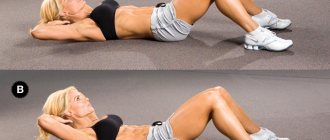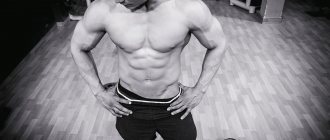How to properly do push-ups on parallel bars
Let's consider classic push-ups on parallel bars with an emphasis on the pectoral muscles. However, when performing them, the entire shoulder girdle is also included in the process.
- The process must happen slowly. Ideally, the rise should last 1 second, and the descent should last 3.
- Starting position: arms straight, holding the bars on top, bending your knees so that an angle of 90 degrees is formed.
- The body needs to be moved forward a little and lowered, bending your elbows.
- Initially, inhalation is done in the upper position. And then during the ascent. Exhale as you lower.
- You can lower yourself until an angle of 90 degrees is formed in the elbow joints. It can be lower, depending on your plans for pumping different areas of the torso. We repeat.
Basic Rules
To benefit from dips and avoid injury, you must adhere to the following rules:
- Before performing the exercise, you need to warm up, which will reduce the likelihood of injury;
- the start of push-ups should be at the top point, since the muscle fibers at the bottom are stretched;
- in addition to the correct technique, it is important to adhere to correct breathing, which also affects the effectiveness of the exercise;
- the width of the beam must exceed the width of the shoulders, otherwise injury may occur;
- Slow and smooth movements contribute to better muscle development.
On a note! For beginners, it is usually difficult to perform push-ups on parallel bars. Therefore, they often ask the question: what can replace this exercise in order to get an equivalent load? Athletes without experience can use the bench by doing bench presses on it. However, the load on the chest in this case will be less.
What muscles are activated during dips?
A wide and developed torso is the dream of every self-respecting man. How he attracts individuals of the opposite sex is a completely different story. No exercise machine can help you the way these two magical parallel wands can help you. They will fully work out: shoulders, arms and chest. During simple but effective work on this apparatus, every millimeter of your muscle fibers will be fully used. And when working with additional load, they will beg you for mercy, but do not listen to them. They will get used to these loads and become stronger, more resilient and naturally larger in volume.
Techniques for working out different muscle groups
- Compound exercises are always more effective for gaining mass and increasing strength. When working on parallel bars, the muscles of the upper body are loaded: pectoral, triceps and deltoid. The load can be adjusted by tilting the body, positioning the hands and the distance between the “boards”.
- When the body is tilted forward, all the emphasis will be on the chest. For maximum effect, you need to bend your knees.
- With a vertical body position and straight legs during lifting, the load will be on the triceps.
- If your elbows point to the sides, the emphasis shifts to the pectoral muscles.
- If you press your elbows as close to your body as possible, the load will go to the triceps.
The effect of projectile width on muscle load
- When the position of the hands on the apparatus is equal to the width of the shoulders, then the triceps muscle is subject to maximum load.
- When the position of the arms is wider than the shoulders, the emphasis will shift to the muscle areas of the chest.
- The ideal width of the projectile is slightly wider than the athlete’s shoulders.
Execution technique
To quickly get the desired result from push-ups, you need to adhere to the correct technique. In the classic version, the exercise should look like this:
- Grab the bars with your hands at a comfortable distance. Palms turned towards the body. The chin is pressed to the chest. The legs are crossed and the shoulders are pulled back.
- Place the main weight on your hands and, inhaling through your nose, slowly lower your body down. The shoulder blades are brought together, the back is straight. The elbow joint forms a right angle.
- Stay in this position for a couple of seconds.
- Exhale through your mouth and slowly raise your body.
Do push-ups the required number of times.
In general, when doing push-ups on parallel bars, the work is done mainly by the arms. If it is difficult to keep your body straight, you can help yourself by tensing your abdominal muscles and buttocks. Jerks are unacceptable. All movements must be smooth to avoid injury.
Safety precautions when performing exercises on parallel bars
These tips will be useful for both novice athletes and seasoned athletes who often ignore the rules.
- The projectile should not wobble.
- The crossbars must be at the same height.
- The first rule of any workout is a mandatory warm-up. Our case is no exception.
- Breathe correctly. Inhalation is done in the upper position of the body in order to eliminate the possibility of injury to the chest.
- Speed in our case is not the main thing. The entire process of lowering and raising the body should last about two seconds.
- Too much distance between the poles can harm your joints.
- A common mistake among beginners is training with weights. You can add weight only when you can perform at least 3 sets of 15 reps.
Training for beginners
If you are just starting to build your muscles, then parallel bars are a great tool for pushing all pressing exercises such as bench press, dumbbell press, etc.
- If a beginner cannot complete a single repetition on the apparatus, then this is of course sad, but not critical. You should not immediately lean on advertised steroids. There is another way out of this situation - you need to start with simple push-ups from the floor. It’s better to do fewer presses, but for more approaches.
- If classic push-ups from the floor are not easy for a beginner, then you need to start doing push-ups from your knees, or put your hands on a hill. Thus, the pressure on the muscles will decrease.
- When you learn classic push-ups and accumulate enough strength, then you can safely go to the site and start conquering the uneven bars. If you've done a couple of reps, even with difficulty, then you've already won. Under no circumstances should you be ashamed to do this several times with trembling hands.
- Do many sets once or twice, increasing the number over time.
Many beginning bodybuilders had this kind of training program on parallel poles when they were small and weak.
How effective are exercises?
Many people don’t understand why the simplest exercise routine on the uneven bars is so effective? In this matter, the right approach and well-developed technique are important. Regular training can successfully replace exhausting strength training in gyms, namely bench press with a barbell or dumbbells on a horizontal or inclined bench.
An important advantage of the bars is that there is no need to purchase special equipment, since this equipment is available in almost all yards. The fact is that not everyone has time to go to the gym.
Training for mass gain
The growth of muscle mass directly depends on the time that muscle fibers spend under load. So lift and lower your body slowly.
- Exercise number one is, of course, classic dips.
- You can also perform horizontal push-ups with this tool. The athlete's legs and arms are placed on the bars, they are performed as on the ground, only they have a significant advantage - the ability to increase the amplitude of movement by bending below the bars.
- Naturally, training alone will not be enough to gain muscle mass. You will also need proper nutrition and proper rest.
- To work on mass, you will need to do 5 sets of maximum repetitions without weights. Rest between sets should not be more than 3 minutes. With weights there are also 5 approaches, only 5 repetitions each.
For maximum results, use different widths of the projectile, position of the arms and body, depending on which muscle group you want to pump at the moment.
Advantages and disadvantages
Like any other physical exercise, dips have their advantages and disadvantages. The main advantage is high efficiency, and the disadvantage is the high likelihood of injury. This means that this exercise can only be done if there are no contraindications. If pain occurs during the process or your health worsens, you need to stop training.
The benefits of dips, which are a basic exercise for all types of bench press, are obvious:
- effective training of certain muscle groups;
- promotes broadening of the shoulders, drawing of the relief, increasing the volume of the delta;
- helps develop athletic posture;
- increases muscle mass.
Despite the obvious benefits, there are some disadvantages:
- good physical fitness is required to perform dips;
- There is a heavy load on the shoulder joint, which often leads to injury.
However, in the absence of contraindications and following the correct technique, the likelihood of injury can be minimized. As a result, the exercise will be extremely beneficial.
Weight training
If you can easily manage 12-15 reps in several sets, then it's time to try increasing the weight you lift. There are special weight belts and vests. It is better to use a special belt; it is wide and comfortable and will protect you from injury. First, attach a light weight plate to your belt. Do 10-12 repetitions in each set. Gradually change the pancakes to heavier ones. A complex with weights will have a positive effect on body weight.
Terrain training
A pile of muscles is not a victory. Especially if they are hidden by ominous fat. For the final result, so that they look beautiful and aesthetically pleasing, you need to reduce its content in the body, without losing muscle mass. To do this we will need: a diet, intense training and possibly various fat burners and protein shakes.
- When working with uneven bars, you should do 10 to 15 or more repetitions.
- It is required to reduce the rest period between sets to 1-2 minutes.
- You should use a weight with which you can perform the required number of repetitions, taking into account that you reduce the rest time.
- Use a drop set - performing an exercise with a decrease in weight right in the middle of the approach itself.
- Also, when training for relief, good results are achieved by such a technique as a superset - this is performing two exercises in a row without rest.
A training program on the horizontal bar and uneven bars will give more tangible results than training on any one individual implement. For almost all bodyweight enthusiasts, these two brothers are inseparable.









